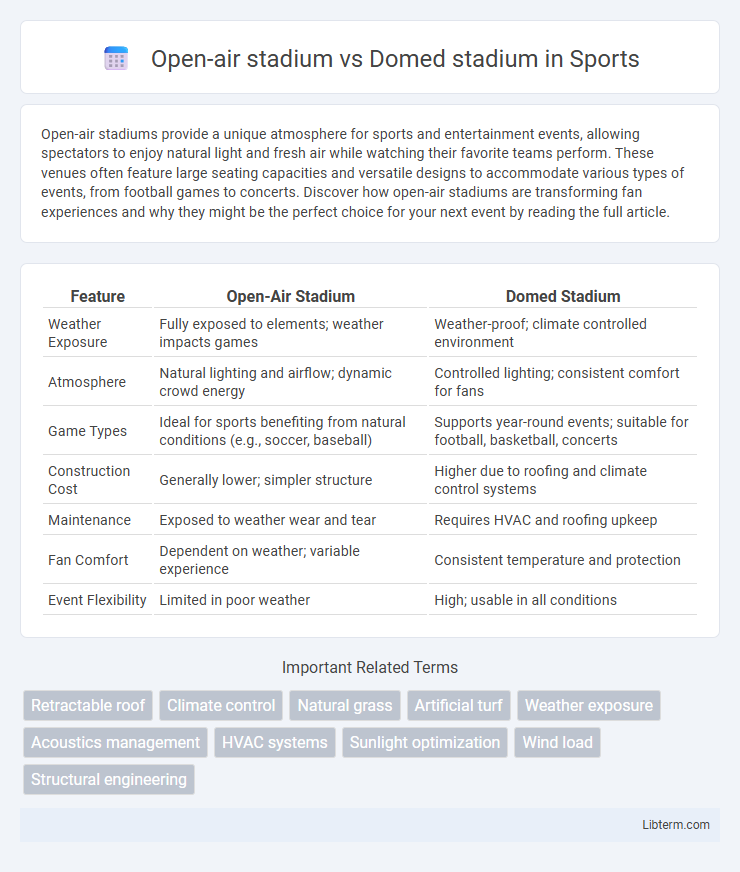Open-air stadiums provide a unique atmosphere for sports and entertainment events, allowing spectators to enjoy natural light and fresh air while watching their favorite teams perform. These venues often feature large seating capacities and versatile designs to accommodate various types of events, from football games to concerts. Discover how open-air stadiums are transforming fan experiences and why they might be the perfect choice for your next event by reading the full article.
Table of Comparison
| Feature | Open-Air Stadium | Domed Stadium |
|---|---|---|
| Weather Exposure | Fully exposed to elements; weather impacts games | Weather-proof; climate controlled environment |
| Atmosphere | Natural lighting and airflow; dynamic crowd energy | Controlled lighting; consistent comfort for fans |
| Game Types | Ideal for sports benefiting from natural conditions (e.g., soccer, baseball) | Supports year-round events; suitable for football, basketball, concerts |
| Construction Cost | Generally lower; simpler structure | Higher due to roofing and climate control systems |
| Maintenance | Exposed to weather wear and tear | Requires HVAC and roofing upkeep |
| Fan Comfort | Dependent on weather; variable experience | Consistent temperature and protection |
| Event Flexibility | Limited in poor weather | High; usable in all conditions |
Introduction to Stadium Types
Open-air stadiums offer natural ventilation and sunlight, enhancing the live sports experience while exposing attendees to weather conditions. Domed stadiums feature enclosed structures with climate control systems, providing protection from rain, wind, and extreme temperatures, ensuring consistent event conditions. Each stadium type affects factors such as construction costs, maintenance, and spectator comfort differently.
Architectural Design Differences
Open-air stadiums feature open roof structures that emphasize natural ventilation and sunlight, often incorporating large cantilevered stands for unobstructed views. Domed stadiums utilize enclosed, often retractable, roofing systems that enable climate control and protection from weather, requiring complex structural support such as large-span trusses or air-supported membranes. The architectural design of open-air versus domed stadiums impacts material selection, structural engineering, and spectator experience by balancing exposure to natural elements against controlled environments.
Weather Impact on Events
Open-air stadiums expose events to natural weather conditions, which can affect athlete performance, spectator comfort, and event scheduling due to rain, wind, heat, or cold. Domed stadiums provide a controlled environment, eliminating weather-related disruptions and ensuring consistent playing conditions year-round. Weather unpredictability in open-air venues often requires contingency plans, whereas domed stadiums offer stable climate control and improved acoustics.
Spectator Comfort and Experience
Open-air stadiums offer natural ventilation and panoramic views, enhancing spectator comfort during favorable weather conditions. Domed stadiums provide climate-controlled environments that protect attendees from rain, wind, and extreme temperatures, ensuring consistent comfort regardless of outdoor weather. Acoustic design in domed stadiums often delivers superior sound quality, while open-air venues may experience variable noise levels due to environmental factors.
Maintenance and Operational Costs
Open-air stadiums generally have lower maintenance costs due to simpler structural requirements but face higher expenses related to weatherproofing and field upkeep. Domed stadiums incur higher initial construction and ongoing operational costs driven by climate control, ventilation, and lighting systems maintenance. Energy consumption in domed stadiums significantly increases expenses, while open-air venues benefit from natural ventilation and lighting, reducing utility costs.
Energy Efficiency and Environmental Considerations
Open-air stadiums utilize natural ventilation and daylight, reducing the need for artificial lighting and climate control, which lowers overall energy consumption. Domed stadiums require substantial energy for HVAC systems to maintain indoor comfort and lighting, increasing their environmental footprint. Sustainable design in open-air stadiums often incorporates renewable energy sources and rainwater harvesting, enhancing their eco-friendly advantages compared to enclosed venues.
Versatility and Event Hosting Capabilities
Open-air stadiums provide natural ventilation and sunlight, ideal for sports like soccer and baseball, but face limitations due to weather disruptions, affecting event scheduling and attendance. Domed stadiums offer climate control and adaptable configurations, enabling year-round hosting of diverse events including concerts, conventions, and indoor sports without weather-related interruptions. The versatility of domed stadiums enhances revenue potential and audience experience by accommodating large crowds in comfort regardless of external conditions.
Acoustics and Atmosphere
Open-air stadiums offer natural acoustics that allow sound to dissipate, often creating a more diffuse and ambient atmosphere ideal for large crowds. Domed stadiums enhance sound reflection and containment, resulting in louder, more concentrated acoustics that amplify crowd noise and intensify the atmosphere. Acoustic engineers often design domed stadiums with sound-absorbing materials to balance reverberation and clarity, optimizing the overall auditory experience.
Regional Preferences and Cultural Influence
Open-air stadiums are predominantly preferred in regions with mild climates and strong cultural ties to traditional outdoor sports, such as soccer in Europe and cricket in South Asia, where natural elements enhance the spectator experience. Domed stadiums find favor in areas with extreme weather conditions like the northern United States and parts of Japan, reflecting a cultural emphasis on comfort and year-round usability for events such as American football and baseball. Regional preferences also align with local architectural styles and technological advancements, underscoring cultural values around innovation and community engagement.
Future Trends in Stadium Construction
Future trends in stadium construction emphasize sustainability, advanced technology integration, and fan experience enhancement in both open-air and domed stadiums. Open-air stadiums increasingly incorporate smart shading systems and natural ventilation to improve comfort while reducing energy consumption. Domed stadiums benefit from retractable roofs and adaptive climate control, allowing year-round versatility and event hosting in diverse weather conditions.
Open-air stadium Infographic

 libterm.com
libterm.com